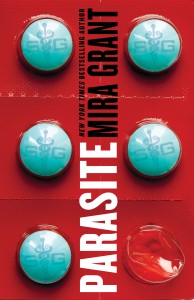Sally Mitchell has no memories of life before her car accident, and without the medically-inserted tapeworm that regulates her system, the “Intestinal Bodyguard” created by pharmaceutical company SymboGen, she wouldn’t even be alive. As Sal adjusts to her new life, she struggles with being a six-year-old in a twenty-six-year-old body and with the terrifying consequences of what the medical tapeworm is doing to the rest of the world.
 Upfront, I’ll admit I totally geek out for near-future, fringe science-centered science fiction novels, so as far as I’m concerned, books like PARASITE are the best kind of sci-fi: the kind of science described in the book isn’t available today, it’s well-explained enough to feel eerily close to today.
Upfront, I’ll admit I totally geek out for near-future, fringe science-centered science fiction novels, so as far as I’m concerned, books like PARASITE are the best kind of sci-fi: the kind of science described in the book isn’t available today, it’s well-explained enough to feel eerily close to today.
Overall, I found the plot and the universe of PARASITE much more engaging than the characters, though I found a lot of the characters interesting as the plot progressed. The plot is set in 2027, and that makes the universe close enough to be relatable while still eliciting a feeling of futuristic wonder, one reason that I love the science fiction genre as a whole.
But this book is not for the squeamish. A lot of time is spent developing the “Intestinal Bodyguard,” from its creation to the fates of its creators, only one of whom appears to be with the company. The engineering of a two-foot-long parasitic tapeworm is scientifically fascinating, but really roils the stomach in certain ways, and other revelations about how the tapeworm was designed to fit in the human body – some of them are pretty icky and, again, not for the squeamish.
The structure of PARASITE has a fascinating way of building the plot, though much of it contains the above-mentioned ickiness. Each chapter is preceded by “clips” and “quotes” from magazines, newspaper articles, an autobiography and a children’s book, each quote relating in some way to Sal and her journey or to the “Intestinal Bodyguard” and its creators. Throughout the book, the quotes slowly reveal more about some characters than dialogue or action could show, revealing some narrators as unreliable while building a case for others.
On the other hand, I didn’t really like the fact that the story was the slow start. While I was really interested by the summary and thought it sounded really cool, it took several chapters to feel emotionally invested in Sal, the protagonist-narrator. Also, the primary “plot twist” of the novel seemed incredibly obvious to me, though it’s thoroughly foreshadowed and the protagonist herself acknowledges she’s been denying it.
But once the ball got rolling, it was rolling fast. The pace of the novel picks up about a quarter to a third of the way in, and after that point, it’s incredibly fascinating, especially for those fascinated by the actual scientific concepts explored in the story. As for the “plot twist” itself? Once the reader figures it out, much of the novel makes perfect and complete sense.
I’d recommend PARASITE for readers who truly enjoy fringe science and are more interested in world-building, plot and science than the development of the protagonist. It’s an engaging read – especially for lovers of books like PEEPS by Scott Westerfeld looking to graduate to adult sci-fi.
4 out of 5 stars
Feliza Casano is the founder and editor in chief of Girls in Capes and writes for all sections of the web magazine. She’s not a terribly squeamish individual, as long as there are no photographs. Follow her on Twitter @FelizaCasano.






